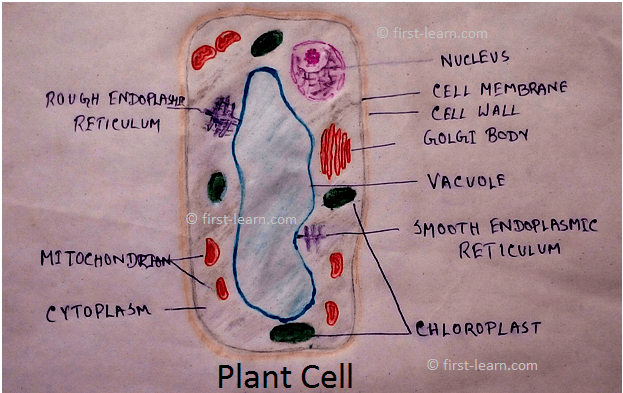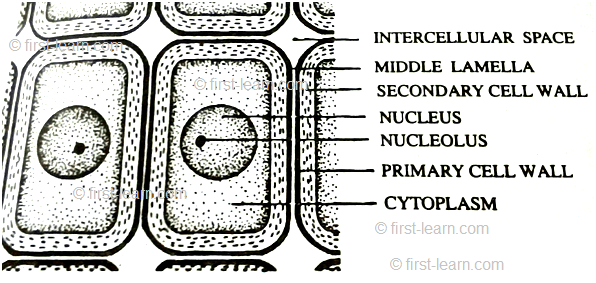Eukaryotic Cell
Definition of Eukaryotic Cell - It is a type of cell which contains well defined nucleus, membrane bound organelles.
Examples of Eukaryotic Cell - Eukaryotic cells are present in all higher plants and animals. It is also present in some lower animals like fungi, protists etc.
Types of Eukaryotic Cell - Eukaryotic cell can be divided into two- plant cell and animal cells according to their presence of organelles.
Different Parts of Eukaryotic Cell - Eukaryotic cells are made up of cell membrane, different membrane bound organelles like mitochondria, endoplasmic reticulum, plastids (in plants), Golgi body, lysosome, ribosome, centrosome (in animals) , inclusion bodies etc. In plant cell, cell wall is present but it is absent in animal cells.
Different type of cell organelles are following:
1. Cell Membrane - It is made up of proteins lipid protein layer means trilamillar. It provides mechanical support to the cell and covers the cytoplasm and the organelles of the cell.
2. Cellwall - Cell wall is the thick, rigid, non-living outer most covering which is present just outside the plasma membrane of plants cells are called cell wall. It is absent in animal cells. It consists of middle lamellae, primary cell wall, secondary cell wall. It’s main function is to provide shape, mechanical support, protection, intercellular connections, and control the entry and exit of different materials from the cells.
3. Cytoplasm - The fluid like substances or the semi liquid and granular part of the cell that remains extended from the plasma membrane to the nuclear membrane is known as cytoplasm. It consists of three parts. Those are cytoplasmic matrix, cytoplasmic organelles, cytoplasmic inclusions or ergastic substances.
Cytoplasmic organelles are followed below:
4. Mitochondria - Mitochondria is one of the most important organelles of eukaryotic cell which is a rod shape, filamentous, spherical oval, double membrane bound cytoplasmic organelles of eukaryotic cells which are concerned with cellular respiration are called mitochondria. Mitochondria is called the power house of the cell.
Various metabolic enzymes are present in mitochondria,as a result it is the most important site for cellular metabolism. It is associated with synthesis of fatty acids and production of DNA, RNA, proteins. Main enzymes of the TCA cycle, electron transport chain, oxidative phosphorylation are occurred in mitochondria.
5. Ribosome - Ribosomes are cell organelles which found both in Prokaryotic cell and eukaryotic cell. These are small, granular, non membranous structures which is made up of RNA and protein and are concerned with protein synthesis. Prokaryotic ribosomes are 70s in nature whereas eukaryotic ribosomes are 80s in nature.
6. Endoplasmic reticulum - Endoplasmic reticulum are membrane bound irregular, network - like vacuolar system present in the cytoplasm of eukaryotic cells. It’s functions are to provide mechanical support, formation of other granules, exchange of materials, protein synthesis,lipid synthesis, carbohydrates metabolism, detoxification etc. It is of two types rough endoplasmic reticulum (associated with protein synthesis and remain bound to the ribosome) and smooth endoplasmic reticulum (associated with lipid and carbohydrate synthesis).
7. Golgi Body - Golgi bodies are cell organelles which are smooth surfaces, membrane enclosed organelles of eukaryotic cells which are associated with secretions.
8. Plastids - it is a cell organelles which is double membrane bound, pigmented or no pigmented cytoplasmic organelles found in plant cells which is concerned with the manufacture or storage of the food or colouration. Different types of plastids are chloroplast, chromoplasts, leucoplast.
9. Lysosome – Lysosomes are organelles that are found in both plant and animal cells that are membrane-bound vesicular cytoplasmic organelles contains hydrolytic enzymes.
10. Centrosome - Centrosome is a type of organelles found in animal cell which is more or a less spherical mass of dense cytoplasm situated close to the nucleus and contains a pair of cylindrical bodies that are concerned with spindle formation during cell division.
11. Ergastic Substances - It contains stored food, secretory matters, excretory matters, pigments.
12. Vacuoles - Vacuoles are membrane bound which is apparently empty spaces or cavities within cytoplasm.
13. Nucleus - It is the most important part of the cell or is the main control centre of the eukaryotic cell which is membrane enclosed part, contains chromosomes.It contains nucleolus, nucleur membrane, nucleur reticulum, nucleoplasm.
Comparison between Prokaryotic cells and eukaryotic cells:
1. Eukaryotic cells are generally larger and are more organised than prokaryotic cells.
2. Protoplasm of the eukaryotic cells are clearly divisible into cytoplasm and nucleus but prokaryotic cells do not contain well defined nucleus.
3. In eukaryotic cells, nucleus is well organised and nuclear materials are enclosed without it but in prokaryotic cell it is absent.
4. Membrane bound organelles are observed in eukaryotic cells but it is absent in prokaryotic cell.
5. In prokaryotic cell nuclear materials are remain scattered in the cytoplasm.
6. Basic histone proteins are present in eukaryotic cells where the DNA s remain bound around it but is absent in prokaryotic cell.
7. Ribosomes are 70s in prokaryotic cell and 80s in eukaryotic cells.
8. Flagella are simple in Prokaryotic cells but are complex in eukaryotic cells.
9. Mitotic apparatus are present in eukaryotic cells but are absent in prokaryotic cell.
Questions and answer of Eukaryotic Cell:
1. How many types of membrane transport are observed in cell membrane?
Two types of transportation are observed in cell membrane- one is active transport and the other is passive or inactive transport.
2. What do you mean by glycocalyx?
It is the outer covering of the animal plasma membrane which is made up of glycoproteins or mucopolysacharide.
3. Where does cell junctions are observed? How many types?
Cell junctions are observed only in some type of animal cells. It is of four types- tight junctions, gap junctions, desmosome, intercalated disc.
4. What are microvilli?
In some places of animal cells there are folding of membranes are observed which is finger like projections. It is mainly found in epithelial cell of renal tubules , intestine etc which increases the surface area of the membrane and help in absorption.
5. What is cams?
Cell adherence molecules are called CAMS. This are molecules which are associated with cell adhesion.
6. What are the modifications observed in Endoplasmic reticulum?
In some cells of the body endoplasmic reticulum are modified to form – sarcoplasmic reticulum, myeloid bodies, annulate lamellae, glycosomes, microbodies, microsomes.
From Eukaryotic Cell to HOME PAGE
Recent Articles
-
What Is Plasma? | Blood Plasma | Proteins | Nutrients | Cholesterol
Nov 07, 25 10:29 AM
Blood is a mobile fluid which is a connective tissue and is derived from the mesoderm like cell any other connective tissue. Colour of blood is reddish and that flows inside the blood vessels by means… -
Disorders of Respiratory System | Tuberculosis | Pleurisy | Emphysema
Oct 28, 25 11:39 PM
Tuberculosis is very common disease and is caused by a type of bacteria called Mycobacterium tuberculosis. This disease causes different trouble in the respiration and infection of several parts of th… -
Regulation of Respiration | Respiratory Centres | Inspiratory Area |
Oct 14, 25 12:13 AM
Respiratory Centre is the area that controls the rate of respiration and it is observed to be located in medulla oblongata and pons. Respiratory Centre has the following will dispersed components like… -
Explain Transport of Gases | External Respiration | Tissue Respiration
Oct 09, 25 11:35 PM
In humans gaseous exchange is completed in the following ways the steps are - External Respiration or Breathing - Breathing in false taking in of Oxygen and giving out of carbon dioxide in the body. M… -
Kind and Number of Teeth | Location of Teeth in Mouth | Care of Teeth
Sep 11, 25 12:52 AM
Kind and Number of Teeth
















New! Comments
Have your say about what you just read! Leave me a comment in the box below.